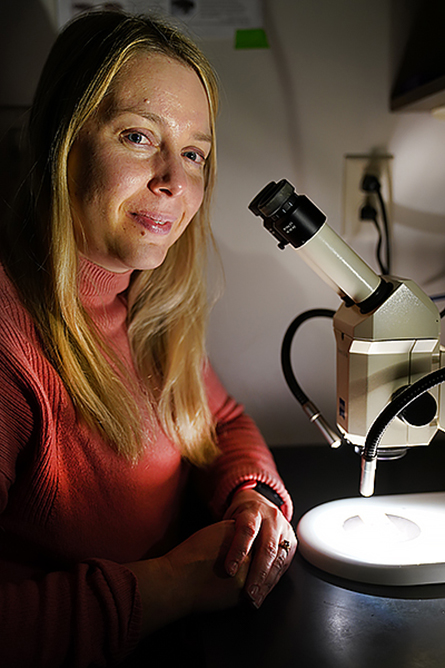A study of old flies offers new insight into retinal degeneration

“Imagine if we could slow or prevent vision loss from retinal degeneration,” said Vikki Weake, associate professor of biochemistry in Purdue University’s College of Agriculture, who led the study. “To do this, we need to understand the molecular mechanisms that drive age-associated changes and the external and internal factors that influence them. In this study, we discovered the circadian clock plays a surprisingly significant role in age-related changes in the retina. This internal clock may be critical in advanced age to prevent retinal degeneration and maintain eye health.”
The team studied the eyes of Drosophila flies, a common model for the human eye. However, the study was uncommon in its use of multiple time points during aging, focus on photoreceptor neurons and new data analysis approaches. The findings are detailed in a paper in PLOS Genetics.
“In our earlier studies, just focusing on gene expression, we were missing part of the story,” Weake said. “By looking at changes in chromatin that alter access to the underlying DNA during aging, we were able to identify some of the transcription factors that drive these gene expression changes in the aging eye.”
Weake acknowledges doctoral student Juan “Jupa” Jauregui-Lozano for the idea for and application of the bioinformatics technique used.
“I came across a powerful bioinformatics technique that can identify changes in transcription factor activity, helping us to understand gene regulation,” Jauregui-Lozano said. “The results revealed that the transcription factors Clock and Cycle - known for their role in circadian rhythm – showed progressive changes in activity with age. This fits with what we know about eye biology, and this unbiased approach led us to identify Clock and Cycle as interesting targets to study.”

The technique, called diffTF, looks at changes in DNA accessibility in chromatin between different conditions. It generates a panel of potential candidates to pursue, as opposed to a research team beginning with a target gene in mind.
“Clock and Cycle were known for being master regulators of circadian rhythms, but we saw they also regulate nearly all of the genes involved in sensing light in the retina,” Jauregui-Lozano said. “When the Clock:Cycle complex is disrupted, flies are susceptible to light-dependent retinal degeneration, and light-independent increase of oxidative stress. In humans, disruption of circadian rhythms has been associated with the onset of several age-related eye diseases. This is another piece of the puzzle.”
Regulating the time at which these proteins are made is important to protect the light-sensing neurons and retain vision, Weake said.
“The proteins involved in sensing light are delicate and degrade during the day when they are exposed to light,” she said. “If the circadian clock is off and these proteins aren’t made at the right time, it’s a problem.”
The study found this complex controlled gene expression of nearly 20% of the active genes in Drosophila photoreceptors. The study also found the complex was responsible for maintaining global levels of chromatin accessibility in photoreceptors, a critical step in transcription of genes.
Co-author Hana Hall, research assistant professor of biochemistry at Purdue, performed light and dark experiments to see the effect on gene transcription when she was a researcher in Weake’s lab.
Unlike most cells in the human body, neurons don’t divide and replicate. The death of neurons lead to degenerative disease, Hall said. Because of this the cellular processes involved in repairing and regulating them are especially important. Proteins achieve this, and genes control which proteins are produced.
“Aging is the main risk factor for neurodegenerative disease,” Hall said. “If we can understand the mechanics of how things get off track or become misregulated in our later years, we may be able to prevent or slow down the progression of these diseases. Vision loss affects a person’s lifespan, independence and quality of life. Even delaying onset by five years could make a tremendous difference. We have ideas, and we are going to seek the answers.”
The research team also included doctoral student Sarah Stanhope and undergraduate students Kimaya Bakhle and Makayla M. Marlin.
The National Eye Institute of the NIH (R01EY024905) and the Bird Stair Research Fellowship and Ross Lynn Research Scholar funded this work.
This article originally appeared in Purdue University’s Agriculture News and has been republished with permission.
Enjoy reading ASBMB Today?
Become a member to receive the print edition four times a year and the digital edition monthly.
Learn moreGet the latest from ASBMB Today
Enter your email address, and we’ll send you a weekly email with recent articles, interviews and more.
Latest in Science
Science highlights or most popular articles

Mining microbes for rare earth solutions
Joseph Cotruvo, Jr., will receive the ASBMB Mildred Cohn Young Investigator Award at the ASBMB Annual Meeting, March 7–10, just outside of Washington, D.C.

Fueling healthier aging, connecting metabolism stress and time
Biochemist Melanie McReynolds investigates how metabolism and stress shape the aging process. Her research on NAD+, a molecule central to cellular energy, reveals how maintaining its balance could promote healthier, longer lives.

Mapping proteins, one side chain at a time
Roland Dunbrack Jr. will receive the ASBMB DeLano Award for Computational Biosciences at the ASBMB Annual Meeting, March 7–10, just outside of Washington, D.C.

Exploring the link between lipids and longevity
Meng Wang will present her work on metabolism and aging at the ASBMB Annual Meeting, March 7-10, just outside of Washington, D.C.

Defining a ‘crucial gatekeeper’ of lipid metabolism
George Carman receives the Herbert Tabor Research Award at the ASBMB Annual Meeting, March 7–10, just outside of Washington, D.C.

The science of staying strong
Muscles power every movement, but they also tell the story of aging itself. Scientists are uncovering how strength fades, why some species resist it and what lifestyle and molecular clues could help preserve muscle health for life.

